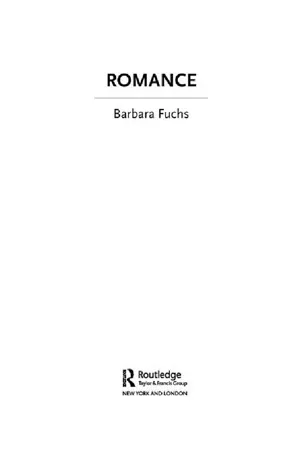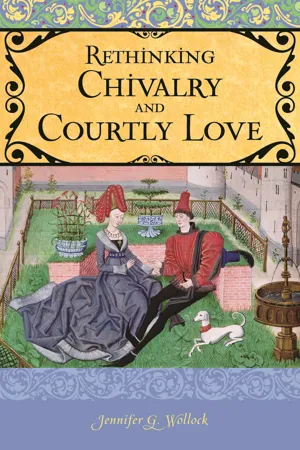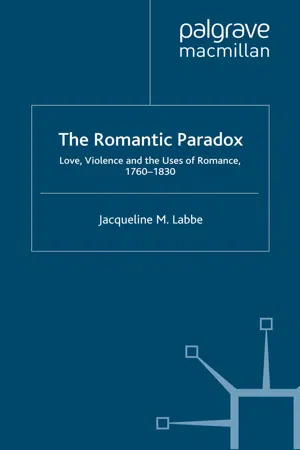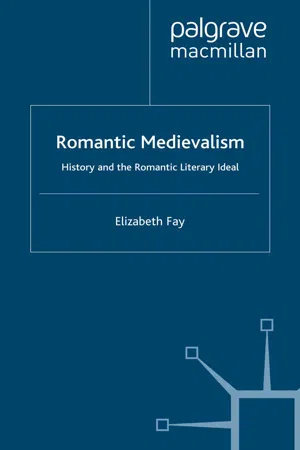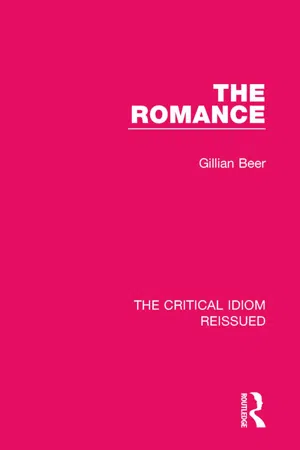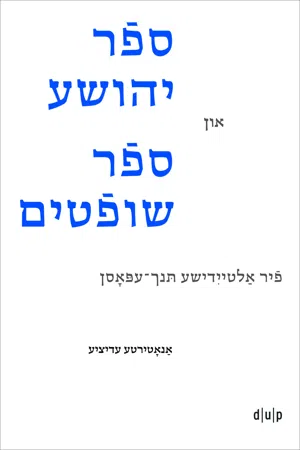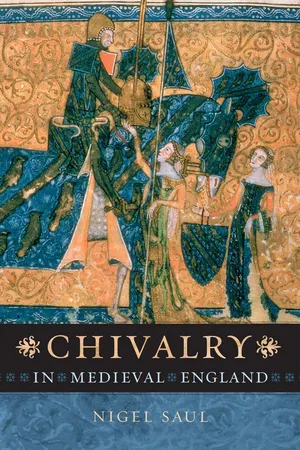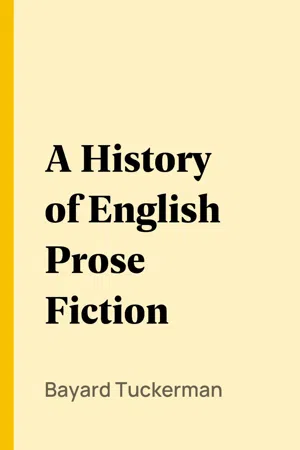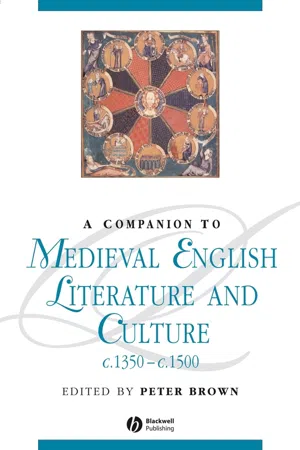Literature
Chivalric Romance
Chivalric romance is a genre of medieval literature that typically features tales of knights, chivalry, and courtly love. These stories often involve quests, battles, and adventures, and they are characterized by a strong sense of honor, bravery, and idealized love. Chivalric romances were popular in the Middle Ages and continue to influence literature and popular culture today.
Written by Perlego with AI-assistance
Related key terms
1 of 5
11 Key excerpts on "Chivalric Romance"
- I then suggest how understanding romance as a strategy might yield a different corpus, cutting across traditional generic categories to encompass hagiography, lais and other vernacular forms. COURTS, KNIGHTS, AND CLERKS The genre of medieval romance is conventionally defined as the group of narratives in the vernacular that emerge around 1150 in the court of Henry II and Eleanor of Aquitaine in England (where Anglo-Norman, a form of French, was the elite language) and tell stories of love and adventure. Although generally situated in a distant classical or Arthurian past, the stories feature all the trappings of contemporary court and chivalric culture, so that, for example, Greek and Roman “knights” skirmish in patently medieval tournaments. The primary sources for this literature are Greek and Roman legends (the story of Thebes, the Trojan war) as well as specific classical texts (Virgil, Statius, Ovid's Metamorphoses, Apollonius), medieval historiography, Celtic legends, and the chansons de geste. Since the thirteenth century, romance has traditionally been divided into three subjects (although many texts classified as romances elude this early characterization): the matter of Rome, which includes primarily reworkings of the story of Troy and the Aeneid ; the matter of Britain, which comprises the stories of King Arthur and his Knights of the Round Table; and the matter of France: stories of the French knights made famous by the chansons de geste. Although the characters might often resemble those of the earlier French epics, in romances there is a much greater emphasis on the private over the public, on the perspective of women, and on the knights' experience of love
- eBook - PDF
The Arthur of the English
The Arthurian Legend in Medieval English Life and Literature
- W R J Barron(Author)
- 2020(Publication Date)
- University of Wales Press(Publisher)
5 Chivalric Romance The distinction between the romances contained in this chapter and those in the previous one is far from clear-cut, not least because texts considered in both involve 'chivalry' in some of the most fundamental senses of the word: characters who are 'knights or horsemen equipped for battle' (OED chivalry n. 1), and actions that are, or should be, informed by an 'ethical code . . . comprising allegiance (honour), valour, generosity, courtly manner' (MED chevalrie n. 5). But what makes the 'Chivalric Romances' distinctive is their concern with the prowess and fortunes of individual knights, even when they also relate the activities of a large company of such knights at court (Ywain and Gawain), in the hunting field (The Awntyrs off Arthure), or on a pilgrimage (Golagros and Gawane). As Auerbach long ago made plain, the primary object of such an individual hero is the pursuit of 'adventure'. Auerbach found his exemplary adventure - and with it the antithesis of the (more dynastic) concerns of the chansons de geste - in the first part of Chretien de Troyes's Yvain, the direct, if much more extensive, source of Ywain and Gawain. It was a natural choice, since this particular adventure is not only complex and impressive in itself, but is described a number of times, at varying length, with different protagonists, and by different narrators; it thus becomes firmly impressed upon the reader's mind, not as 'an' adventure, but as 'the' adventure. What is more, its further development brings the hero to the experience of romantic love, another important element in the Chivalric Romance. It is often said that the effect of such love will be to inspire a romance hero to even greater feats of valour, but this is not always evident in the romances dealt with in this chapter. The connection is explicitly made in Sir Launfal and in Lancelot of the Laik, and - implicitly, and on a very basic level - in The Jeaste of Syr Gawayne. - eBook - PDF
- Jennifer G. Wollock(Author)
- 2011(Publication Date)
- Praeger(Publisher)
7 The Literature of Chivalry A nation which lives a pastoral and innocent life never decorates the shcpherd’s staff or the plough-handle; but races who live by depredation and slaughter nearly always bestow exquisite ornaments on the quiver, the helmet, and the spear. John Ruskin, from The Two Paths, Lecture 1.7 1 Chivalry is a widespread concern in the literature of the European Middle Ages and, to some readers, surprisingly persistent in that of later periods. Chivalric literature encompasses tales of knightly exploits, both true and imaginary, in verse and prose; the chivalric manuals discussed in the previous chapter, song lyrics, and prose treatises on chivalric themes; and, taking the subject in the broadest sense, literature of whatever sort, explicitly chivalric or not, that was produced by the knights themselves. Many of these works do also involve courtly love, seen both positively and negatively, but this chapter concerns their focus on chivalry proper. Narratives, whether true or imaginary, seem from the vantage point of this study to have been the most prominent chivalric literary form, although knights, heralds, and other commentators on chivalry produced lyrics and didactic treatises as well. When the English printer William Caxton encouraged the English knights of 1484 to give up the bathhouse and the gaming table for chivalric remedial reading, his booklist focused on fictional and factual accounts of the “noble actes” of the British kings and knights of the past. The Grail knights—Lancelot, Galahad, Perceforest, Percival, and Gawain—are succeeded after the Norman Conquest by Richard the Lionhearted, Edward I, Edward III, Henry V, and their knights, “whoos - eBook - PDF
The Romantic Paradox
Love, Violence and the Uses of Romance, 1760-1830
- J. Labbe(Author)
- 2000(Publication Date)
- Palgrave Macmillan(Publisher)
Clearly, the genre was viable and deeply significant. Why? And how? 16 The Romantic Paradox Critical chivalry For many critics rediscovering the romance, its worth lay in the chivalric world created by knights, ladies, castles, and courtly values. The belatedness of John Batty's 1890 study The Spirit and Influence of Chivalry only emphasises this point; he is lyrical, even rhapsodic in his proposal that chivalry is the basis for all virtuous human (that is, male) action: 'Oh! what would become of the human race if the spirit of self-sacrifice, which is one of the brightest gems in the crown of chivalry, became extinct?' 9 Batty's examples of modern chivalry - manning lifeboats, rescuing trapped miners, saving a drowning child - rely on a gentlemanly sense of noblesse oblige and right; writing at the end of a century that refocused attention on the medieval romance as narrative, he is fulsome in his praise of its values. Inhabiting his account of courtly behaviour, however, is a sanitised form of violence: 'The highest development of the chivalric idea gives a spiritual aspect to chivalry - in fact, makes it the exponent of Christianity ... religion put in action' (84). This religious chivalry translates into the Christian's fight for his faith: By sacred and allegorical writers this world has been frequently represented as a scene of spiritual warfare, the foes in the field against which the Christian has to fight being those of the world, the flesh, and the devil [L]ife is a constant struggle against evil ... in order to overcome it The weapons of this spiritual warfare are taken from the 'armoury of knighthood', and are made use of metaphorically to illustrate the doctrines and truths of Christianity. Thus St. Paul ... says 'put on the whole armour of God', 'taking the shield of faith', 'the helmet of salvation', 'the sword of the Spirit', and so on. - eBook - PDF
Romantic Medievalism
History and the Romantic Literary Ideal
- E. Fay(Author)
- 2001(Publication Date)
- Palgrave Macmillan(Publisher)
Courtly love, introduced after chivalry is already in place, is another such shift. Its focus on the lady as the object of desire insists that the individual male subjectivity be formulated and circulated in relation to this object as a self-consciously divided subject. The cultural field that Romantic Medievalism: The Ideal of History 21 gave rise to troubadour poetry also invested chivalry, originally referring to the cavalier or warrior class, with its own idealized motifs: loyalty, truthfulness, courtesy, hardiness, humility and generosity. Troubadour poetry adjudicates the new code of chivalry, in itself an ideological template to replace the knight's reality: bawdy or military manners, and a confirmed habit of bashing his lady's nose to teach her humility and subservience. While romance transfigures the martial lord into the knight-errant, the figure by which history remembers him (Ferguson, The Chivalric Tradition 17), the troubadour poem encodes a refined love practice that can be interpreted within the chivalric code that references it. Furthermore, if courtly love arises, Gaunt suspects, as a response to the Church's marriage reforms which targeted aristocratic marriage con- tracts, and gave women for the first time the right of refusal, a misogyn- istic and parodic inversion of courtly love could help adjudicate tensions surrounding women's new expressive power while being beheld as a speculative object in courtly love. 32 Although the troubadour's signal achievement is the creation of `true' love, this is a fantastic relation that politicizes love and desire by making sight and sound absent presences. Accompanying this virtual love is the tensed homosocial and politicized competition that accountably in- trigues later poets, particularly the Romantics; the textual relation be- tween poet and lady encodes a challenge to male authority that can stand in for any act of political resistance to patriarchal authority. - eBook - ePub
- Gillian Beer(Author)
- 2017(Publication Date)
- Routledge(Publisher)
Epic and Romance, ‘medieval romance passes out of itself’.ELIZABETHAN ROMANCE
The strong emblematic power of the romance genre tended to protect unskilled practitioners. Yet the ideal world of the romances can only find meaningful form through creative precision just because it is ideal. Unless the romance includes a robust particularity there is something specious, something too easily claimed, about its appeal. It resolves into emblems of desire. There is nothing inimical to serious art in the wish to escape the common conditions of life. But wish-fulfilment must be fully, kinetically, acted out with all its attendant pain within the work of art, not proffered like sweetmeats. The suspicion that the romance world is essentially a lie – not only because it is unhistorical but because it is not equivalent to the actual world and not realizable within it – underlies much renaissance and post-renaissance criticism of the form.But Elizabethan critics were concerned particularly by the sheer popularity of the form. It must be emphasized that the word ‘romance’ in the sixteenth century could be used for any kind of secular story in verse or prose. The word reaches its widest spectrum of meaning at this period and it is consequently difficult to use it as a defining or characterizing term; we can, however, usefully distinguish its varieties. The principal sources for Elizabethan romance were the chivalric matter of medieval courtly romance; the vast store of classical legends which had become familiar through the new classical learning; these same legends, translated and transformed by way of Italian and French versions; the Italian ‘romantic epic’; folk-tale; history. The appetite for stories is shown in the jest-books which reflect popular verbal folk tales, books like A Hundred Merry Tales (1526), The Merry Tales of Skelton (1566–9), Tarlton’s Jests (before 1592), and The Merry Conceited Jests of George Peele (1607). William Painter’s The Palace of Pleasure - eBook - PDF
Joshua and Judges in Yiddish Verse
Four Early Modern Epics. An Annotated Edition
- Oren Cohen Roman(Author)
- 2022(Publication Date)
- Düsseldorf University Press(Publisher)
268 265 SP127c, SM85a. 266 Cf. Targum Jonathan: “ And you did not accept my Memra ” (Harrington and Saldarini 1987, 61). 267 Cf. Targum Jonathan: “ And the Lord received the prayer of Manoah ” (Harrington and Saldarini 1987, 85). 268 Cf. “ And I was not willing to listen to Balaam ” (Targum Jonathan, ibid. [Harrington and Saldarini 1987, 55]). LXXI Introduction The Influence of the Chivalric Romance The four studied epics contain elements of the European Chivalric Romance that add energy and majesty to the biblical descriptions. Such elements draw on the reality portrayed in European romance literature: a world full of battles, in which brave men rely on their swords. The background to these battles, long journeys, encounters with odd creatures, treasure hunts, and so forth is the royal court, where good manners reign supreme. There the powerful king resides with his beautiful daughter, who is courted by knights. Barbara Fuchs describes this atmosphere well: In the narrow literary sense, romance is the name given to a particular genre, the narrative poems that emerge in twelfth-century France and quickly make their way around Europe […]. These poems are typically concerned with aristocratic characters such as kings and queens, knights and ladies, and their chivalric pursuits. They are often organized around a quest, wheth- er for love or adventure, and involve a variety of marvelous elements. 269 In an effort to distinguish between Chivalric Romance and epic, Atsuhiko Yoshida argues that an epic sets an example of courage on a national lev- el, whereas romance lacks a noble cause. Indeed, the fiction recounted in a romance is merely for the sake of entertainment. 270 Likewise, Chris Baldick claims that the element of romantic love in Chivalric Romance distinguishes it from the epic. 271 By contrast, Fuchs argues that literature is hybrid, and thus the epic, as well as other genres, contains elements of romance. - Maurice Keen(Author)
- 1996(Publication Date)
- Hambledon Continuum(Publisher)
It is not difficult to show that the romances in which courtly loving played such a prominent part were regarded — among other things — as a quarry of examples of virtuous living which had present relevance; but that does not necessarily mean that their amorous passages were con-sidered to have the same kind of contemporary relevance as their tales of martial courage and achievement. They do show how ideals depicted in romance could be related to realities, but they do not therefore prove that courtly love could be related to reality in that way, and that so we should 'believe in it'. But if we have not quite got to that point, we have, I think, been given some help toward finding a way forward with our problem. Since we can see that the ideal pictures of the chivalrous heroes of pseudo-historical fiction were regarded as models, we shall be wise to start by looking further at those contexts in real life to which these 19 William Caxton, The Book of the Ordre ofChyvalry, ed. A.T.P. Byles, EETS, original series, 168 (London, 1926), pp. 122-23. 20 T. Wright (ed), Chronicle de Pierre de Langtoft, RS, 2 vols (London, 1868), ii, p. 296; and see J. Vale, Edward HI and Chivalry (London, 1983), ch. 1. 28 Nobles, Knights and Men-at-Arms in the Middle Ages models were regarded as being particularly relevant, to see if they show us anything about love. We may usefully look back at this point to Chretien's Chevalier de la charrette. One of the great scenes in this romance is the tournament, at which Lancelot first, as an obedient lover, shows himself a coward at Guinevere's command, and then, when she bids him, carries all before him in her presence. 21 This tournament had been arranged by the ladies of Noauz and Pomegloi, and the maidens of the court had resolved that they would give themselves in marriage to those who showed most prowess.- eBook - PDF
- Nigel Saul(Author)
- 2011(Publication Date)
- Harvard University Press(Publisher)
14 Chivalry and Women According to the hostess in the fourteenth-century English poem Sir Gawain and the Green Knight , ‘the choicest thing in chivalry’ is knights doing deeds for their ladies. 1 Chivalry in the hostess’s sense ritually elevated women, investing them with power over their menfolk and giving them the means to play games with suitors for their favour. At the same time, however, in a different way chivalry left women in an ambivalent position, reducing them to mere objects of male desire and making them appendages of men in a male-dominated society. Chivalry was a novelty in medieval aristocratic culture in that it provided a structuring framework for relations between the sexes. While principally an ethic conceptualising the values of knighthood, it also established new sexual mores. It laid emphasis on eros (love) in place of the platonic and intellectual agape of old. The relationship between chivalry and gender as mediated to us in the romance literature of the Middle Ages was one fraught with ambiguity. Sexuality and Courtly Love What we recognise today as courtly love was essentially the anguished longing of the male lover which was so powerfully explored by the lyric poets of the twelfth century. The mood of this new lyric poetry could hardly have been more different from the mood of the love poetry written in classical antiquity. The Greeks and more especially the Romans had treated love as a sickness, a fever, a source of pain. Love was not idealised, much less invested with the semi-religious aura to be found in the literature of the Middle Ages; at times it was treated as a tragic madness. The god of love was a jealous and despotic god, a deity who teased and tormented those in his thrall. The tender quality of twelfth-century poetry contrasted sharply with the often quizzical character of the work of antiquity. - eBook - ePub
- Bayard Tuckerman(Author)
- 2005(Publication Date)
- Perlego(Publisher)
The examples presented in romantic fiction of manly courage, of self-sacrificing devotion, of simplicity of character, and of chivalric consideration for the weakness of the female sex, may excite our admiration and sympathy, as well as that of a fierce and untutored knighthood. These tales were the product of the English mind in its boyhood, and it is to the youth of our day that they are best adapted and most attractive; but the rationalism of the nineteenth century may find in their spirit of simple faith, of unquestioning belief and trust, much that is beautiful in human life which modern thought and science have swept away. It is on account of the enduring character of the ideals, of which the Arthurian legends were the spontaneous expression, that these works, although contained in a rude form, without artistic plan or literary merit to give them permanence, have never wholly passed from the acquaintance of men. The rude force and beauty of mediæval fiction has been deeply felt by many of the greatest minds which have contributed to modern literature. To the perusal of the story of Launcelot and Guenever Dante ascribes the coming of Paolo and Francesca al doloroso passo. While the other works of Ariosto have fallen into obscurity, his "Orlando Furioso" has achieved a lasting fame. One of the greatest poems in the German language, the "Oberon" of Wieland, is almost a reproduction of a Chivalric Romance. The reader of Milton is often reminded of Uther's son, Begirt with British and Armoric knights. [24] Spenser transferred romantic fiction into the region of allegory, and gave to English literature the immortal "Faery Queen." In our own day the "Idyls" of Tennyson have made the legends of Arthur a part of our common thought, and the Knights of the Round Table familiar in almost every household - Peter Brown(Author)
- 2008(Publication Date)
- Wiley-Blackwell(Publisher)
Love comes to mind at once as an inseparable aspect of romance genre. Is not romance basically about knights and ladies? Lancelot, Guinevere (and Arthur), Tristan and Isolde (and Mark) play crucial roles in the Morte Darthur ; the first three also dominate the Stanzaic Morte Arthur . In these works and others drawing heavily on French originals love language appears – in Ywain and Gawain , for example. And love generates action in less famous works. Eglamour, ill for love, does all to win his lady; Guy of Warwick fills thousands of lines with action designed to win the love of Felice. An insistence on analytical caution will win no popularity, but is necessary. Even in such unsurpassed tellings as Malory’s the love themes show the general unease of Middle English literary works over highly formal courtly love ideas originating in France. And in English romance, as in French, misogynistic sentiments are spoken (e.g. Troy Book 129, Prose Merlin 59). Moreover, love seems linked to prowess rather than acting as a restraining force on its vigour. We need to look more closely at knights and ladies. A first step is simple. As a knight was not Everyman, he did not rescue Everywoman. The concern is almost exclusively for socially elite women, for damsels and ladies. The Prose Merlin announces the ideal standard: no damsels may be sexually forced in Arthur’s realm (p. 328). The famous chivalric oath in the Morte Darthur likewise intones this standard: no rape of ‘ladyes, damesels and jantilwomen and wydowes’ (p. 75). They are rather to be helped to maintain their rights. Sadly, as with most rules, this one is neces-sary because of contrary behaviour, as the pages of Malory’s book and many others reveal. In the Prose Merlin , three sons of King Lot debate gender relations among the elite with a focus on the lovely daughter of their most recent host.
Index pages curate the most relevant extracts from our library of academic textbooks. They’ve been created using an in-house natural language model (NLM), each adding context and meaning to key research topics.
